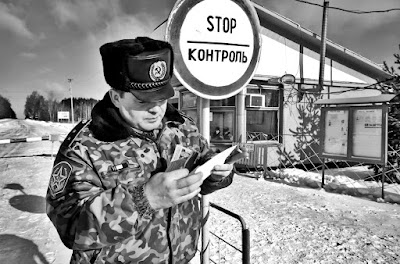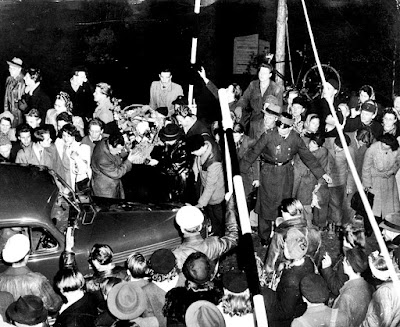Saturday, April 8, 2023
The Berlin airlift during the Berlin blockade
The Berlin Blockade was an attempt in 1948 by the Soviet Union to limit the ability of France, Great Britain and the United States to travel to their sectors of Berlin, which lay within Russian-occupied East Germany. Eventually, the western powers instituted an airlift that lasted nearly a year and delivered much-needed supplies and relief to West Berlin.
From 17 July to 2 August 1945, the victorious Allies reached the Potsdam Agreement on the fate of postwar Europe, calling for the division of defeated Germany into four temporary occupation zones, thus re-affirming principles laid out earlier by the Yalta Conference.
Also divided into occupation zones, Berlin was located 160 km inside Soviet-controlled eastern Germany. The United States, United Kingdom, and France controlled western portions of the city, while Soviet troops controlled the eastern sector.
There had never been a formal agreement guaranteeing rail and road access to Berlin through the Soviet zone. At the end of the war, western leaders had relied on Soviet goodwill to provide them with access. The Soviets also granted only three air corridors for access to Berlin from Hamburg, Bückeburg, and Frankfurt.
After harsh treatment, forced emigration, political repression and the particularly hard winter of 1945–1946, Germans in the Soviet-controlled zone were hostile to Soviet endeavours. Local elections in 1946 resulted in a massive anti-communist protest vote, especially in the Soviet sector of Berlin. Berlin's citizens overwhelmingly elected non-Communist members to its city council.
Meanwhile, to coordinate the economies of the British and United States occupation zones, these were combined on 1 January 1947 into what was referred to as the Bizone, renamed "the Trizone" when France joined on 1 June 1948.
Creation of an economically stable western Germany required reform of the unstable Reichsmark German currency introduced after the 1920s German inflation. In February 1948, the Americans and British had proposed to the ACC that a new German currency be created, replacing the over-circulated and devalued Reichsmark. The Soviets refused to accept this proposal, hoping to continue the German recession, in keeping with their policy of a weak Germany. On 18 June the United States, Britain and France announced that on 21 June the Deutsche Mark would be introduced, but the Soviets refused to permit its use as legal tender in Berlin.
The day after the 18 June 1948 announcement of the new Deutsche Mark, Soviet guards halted all passenger trains and traffic on the
autobahn to Berlin, delayed Western and German freight shipments and required that all water transport secure special Soviet permission. On 21 June, the day the Deutsche Mark was introduced, the Soviet military halted a United States military supply train to Berlin and sent it back to western Germany. On 22 June, the Soviets announced that they would introduce a new currency in their zone.
That same day, a Soviet representative told the other three occupying powers that "We are warning both you and the population of Berlin that we shall apply economic and administrative sanctions that will lead to the circulation in Berlin exclusively of the currency of the Soviet occupation zone." The Soviets launched a massive propaganda campaign condemning Britain, the United States and France by radio, newspaper and loudspeaker. The Soviets conducted well-advertised military maneuvers just outside the city. Rumors of a potential occupation by Soviet troops spread quickly. German communists demonstrated, rioted and attacked pro-West German leaders attending meetings for the municipal government in the Soviet sector.
On 24 June, the Soviets severed land and water connections
between the non-Soviet zones and Berlin. That same day, they halted all rail and barge traffic in and out of Berlin. Surface traffic from non-Soviet zones to Berlin was blockaded, leaving open only the air corridors.
At the time, West Berlin had 36 days' worth of food, and 45 days' worth of coal. Militarily, the Americans and British were greatly outnumbered because of the postwar scaling back of their armies. The United States, like other western countries, had disbanded most of its troops and was largely inferior in the European theatre. The entire United States Army had been reduced to 552,000 men by February 1948. Military forces in the western sectors of Berlin numbered only 8,973 Americans, 7,606 British and 6,100 French. Of the 98,000 American troops in West Germany in March 1948 only 31,000 were combat forces. Soviet military forces in the Soviet sector that surrounded Berlin totaled 1.5 million. The two United States regiments in Berlin could have provided little resistance against a Soviet attack. Because of the imbalance, American war plans were based on using hundreds of atomic bombs.
Although the ground routes had never been negotiated, the same was not true of the air. On 30 November 1945, it had been agreed in writing that there would be three twenty-mile-wide air corridors providing free access to Berlin. Additionally, unlike a force of tanks and trucks, the Soviets could not claim that cargo aircraft were some sort of military threat. In the face of unarmed aircraft refusing to turn around, the only way to enforce the blockade would have been to shoot them down. An airlift would put the Soviet Union in the position of either shooting down unarmed humanitarian aircraft, thus breaking their own agreements, or backing down.
On 25 June 1948 Clay gave the order to launch Operation Vittles. The next day 32 C-47s lifted off for Berlin hauling 80 tons of cargo, including milk, flour, and medicine. The first British aircraft flew on 28 June. At that time, the airlift was expected to last three weeks. During the first week the airlift averaged only ninety tons a day, but by the second week it reached 1,000 tons. This likely would have sufficed had the effort lasted only a few weeks, as originally believed. The Communist press in East Berlin ridiculed the project. It derisively referred to "the futile attempts of the Americans to save face and to maintain their untenable position in Berlin."
So many things had to be flown into Berlin that aircraft took off every three minutes. If an aircraft missed its landing place it could not fly around the airfield and try again, it had to return to its base. This was easier and safer than holding up the aircraft following behind.
The Americans also recruited ex-Luftwaffe aircraft mechanics to help with maintenance, when the Allies realised that the blockade was going to last longer than the expected three weeks.
Hundreds of aircraft, nicknamed Rosinenbomber ("raisin bombers") by Berliners, were used to fly in a wide variety of cargo, ranging from large containers to small packets of candy with tiny individual parachutes intended for the children of Berlin.
278,228 flights were made, and 2,326,406 tons of food and supplies, including more than 1.5 million tons of coal, were delivered to Berlin. At the height of the Airlift, one plane reached West Berlin every thirty seconds. On 21 April 1949, the tonnage of supplies flown into the city exceeded that previously brought by rail.
The Soviet blockade of Berlin was lifted at one minute after midnight on 12 May 1949. A British convoy immediately drove through to Berlin, and the first train from West Germany reached Berlin at 5:32 A.M. Later that day, an enormous crowd celebrated the end of the blockade.
But, the airlift did not end until 30 September 1949, because the Western states wanted to build up enough supplies in West Berlin in case the Soviets blockaded it again.
A total of 101 fatalities were recorded as a result of the operation, including 40 Britons and 31 Americans, mostly due to non-flying accidents. Seventeen American and eight British aircraft crashed during the operation and 39 British and 31 american pilots died during the blockade. There is a monument with their names in front of Tempelhof airport.
The Blockade helped to unify German politicians in support of the creation of a West German state; some of them had hitherto been fearful of Soviet opposition. The blockade also increased the perception among many Europeans that the Soviets posed a danger, helping to prompt the entry into NATO of Portugal, Iceland, Italy, Denmark, and Norway.









